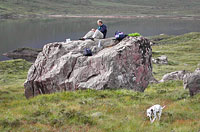
"4000 atoms counted so far this quarter"*



Introduction
Welcome to ESS 460/560, Cosmogenic Nuclides in Geomorphology. You guessed it - it's about cosmogenic nuclides, and how they're used to measure things of interest to geomorphologists - the age of rock surfaces, and how fast surfaces are changing.
High energy cosmic rays penetrate a few meters into the Earth's surface, labelling rock and soil in this outermost layer with "cosmogenic nuclides" such as Al-26, Be-10, Cl-36 and He-3. The build-up of these nuclides after a geologic surface has been freshly created allows us to measure its "exposure age". The first part of the class covers the cosmic ray flux, how it varies with altitude and latitude, and the production of interesting nuclides when cosmic ray particles collide with atoms in rock. After the first few weeks, you will be able to calculate simple exposure ages from cosmogenic nuclide data.
Things get more interesting when we deal with active surfaces. Geomorphic processes that move or rearrange material at or beneath the Earth's surface alter the distribution of cosmogenic nuclides. By measuring nuclide concentrations — in surface samples or depth profiles — and comparing them to the nuclide production profile — we can deduce exposure histories, erosion rates, burial ages, burial rates, and other interesting information.
Instructor
Prof John Stone Office: 345 Johnson Hall Phone: 221-6332 stn@u.washington.edu
David Argento Office: 423 Johnson Hall Phone: 685-3326 dargento@u.washington.edu Prerequisites You will need some math, and a bit of physics will help. Some background on geochronology from ESS 312 or ESS 461 would be useful. I recommend AMATH 301 (Beginning Scientific Computing), which is a fun class, and a good basic math refresher for grad students, who haven't thought about this for a few years. You'll learn MATLAB, and it will get you started on describing natural processes with mathematical models. The series AMATH 351 (differential equations), AMATH 352 (numerical analysis), AMATH 353 (partial differential equations) takes you further than you'll need to go for this class, but covers a lot of the math that every scientist really needs to know (do them - it will make you a better person). If you're coming from outside the UW system and these numbers mean nothing to you, here's what you'll need: Ordinary differential equations, integration (up to trig integrals), some basic numerical analysis, practical statistics and maybe some familiarity with the idea of optimization. Experience with some form of mathematical programming, such as Mathematica, MATLAB, or at least coding in EXCEL, is essential. If you're unfamiliar with these but really want to take the class, let me know, and I can get you started.
Class Timetable
Lecture 2:30 - 3:20 Monday 366 Johnson Hall Lectures, tutorial and labs 2:30 - 4:20 Wednesday 366 Johnson Hall Textbooks
This field is rather new, so no-one has written a textbook yet. I will hand out lots of notes to accompany the lectures, which you'll be able to download from the lectures page.
Of course there is a large and growing scientific literature on cosmogenic nuclides. I will refer to many of the relevant papers in lectures, and post copies on the reading page. You can find many more in the library. Try the Web of Science (for example ...), which gives you access to pdf copies of most recent papers. Google Scholar on the web is another great resource for tracking down papers and searching for cross-referenced material. Note that you'll need a UW NetID to search the Web of Science or download articles from the UW Library links provided by Google
Syllabus and lab schedule
Please see the topic listing and lecture schedule on the lecture handouts download page.
Lab and homework topics, schedule and due-dates are listed on the homework download page.
Grading policyMost weeks there will be homework assignments and problem sets, worth 50% of your overall grade. Get them done and hand them in on time, and you're just about guaranteed to pass the class. The rest of your grade will be based on a take-home exam (more of an open-ended problem set), and a research project. Note that the research project requirement is more challenging if you're a grad student signed up for ESS 560, than if you're taking the class at the 460 level.
Labs, homework and problem sets 50% of your final grade Due dates on the homework schedule Take-home exam 25% of your final grade Due Wednesday November 19th Research project 25% of your final grade Due date to be decided
